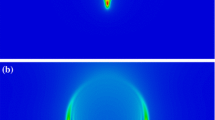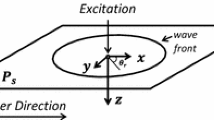Abstract
The recent discovery of shear shock wave generation and propagation in the porcine brain suggests that this new shock phenomenology may be responsible for a broad range of traumatic injuries. Blast-induced head movement can indirectly lead to shear wave generation in the brain, which could be a primary mechanism for injury. Shear shock waves amplify the local acceleration deep in the brain by up to a factor of 8.5, which may tear and damage neurons. Currently, there are numerical methods that can model compressional shock waves, such as comparatively well-studied blast waves, but there are no numerical full-wave solvers that can simulate nonlinear shear shock waves in soft solids. Unlike simplified representations, e.g., retarded time, full-wave representations describe fundamental physical behavior such as reflection and heterogeneities. Here we present a piecewise parabolic method-based solver for one-dimensional linearly polarized nonlinear shear wave in a homogeneous medium and with empirical frequency-dependent attenuation. This method has the advantage of being higher order and more directly extendable to multiple dimensions and heterogeneous media. The proposed numerical scheme is validated analytically and experimentally and compared to other shock capturing methods. A Riemann step-shock problem is used to characterize the numerical dissipation. This dissipation is then tuned to be negligible with respect to the physical attenuation by choosing an appropriate grid spacing. The numerical results are compared to ultrasound-based experiments that measure planar polarized shear shock wave propagation in a tissue-mimicking gelatin phantom. Good agreement is found between numerical results and experiment across a 40 mm propagation distance. We anticipate that the proposed method will be a starting point for the development of a two- and three-dimensional full-wave code for the propagation of nonlinear shear waves in heterogeneous media.






Similar content being viewed by others
References
Taylor, P.A., Ford, C.C.: Simulation of blast-induced early-time intracranial wave physics leading to traumatic brain injury. J. Biomech. Eng. 131(6), 061007 (2009). doi:10.1115/1.3118765
Sosa, M.A.G., De Gasperi, R., Paulino, A.J., Pricop, P.E., Shaughness, M.C., Maudlin-Jeronimo, E., Hall, A.A., Janssen, W.G.M., Yuk, F.J., Dorr, N.P., Dickstein, D.L., McCarron, R.M., Chavko, M., Hof, P.R., Ahlers, S.T., Elder, G.A.: Blast overpressure induces shear-related injuries in the brain of rats exposed to a mild traumatic brain injury. Acta Neuropathol. Commun. 1, 51 (2013). doi:10.1186/2051-5960-1-51
Ryu, J., Szakaly, I.H., Xu, L., Pletnikova, O., Leri, F., Eberhart, C., Troncoso, J.C., Koliatsos, V.E.: The problem of axonal injury in the brains of veterans with histories of blast exposure. Acta Neuropathol. Commun. 2, 153 (2014). doi:10.1186/s40478-014-0153-3
Espindola, D., Lee, S., Pinton, G.: Shear shock waves are observed in the brain. ArXiv e-prints 1705.10672 (2017)
Catheline, S., Gennisson, J.-L., Tanter, M., Fink, M.: Observation of shock transverse waves in elastic media. Phys. Rev. Lett. 91(16), 164301 (2003). doi:10.1103/PhysRevLett.91.164301
Gadd, C.: Use of weighted impulse criterion for estimating injury hazard. Tech rep., SAE Technical Paper (1966). doi:10.4271/660793
Rimel, R.W., Giordani, B., Barth, J.T., Boll, T.J., Jane, J.A.: Disability caused by minor head injury. Neurosurgery 9(3), 221–228 (1981). doi:10.1097/00006123-198109000-00001
Rowson, S., Duma, S.M.: Brain injury prediction: Assessing the combined probability of concussion using linear and rotational head acceleration. Ann. Biomed. Eng. 41(5), 873–882 (2013). doi:10.1007/s10439-012-0731-0
Guskiewicz, K.M., Mihalik, J.P., Shankar, V., Marshall, S.W., Crowell, D.H., Oliaro, S.W., Ciocca, M.F., Hooker, D.N.: Measurement of head impacts in collegiate impact biomechanics and acute clinical outcome after concussion. Inj. Prev. 61(6), 1244–1253 (2007). doi:10.1227/01.neu.0000306103.68635.1a
Darvish, K.K., Crandall, J.R.: Nonlinear viscoelastic effects in oscillatory shear deformation of brain tissue. Med. Eng. Phys. 23(9), 633–645 (2001). doi:10.1016/S1350-4533(01)00101-1
Rashid, B., Destrade, M., Gilchrist, M.D.: Mechanical characterization of brain tissue in simple shear at dynamic strain rates. J. Mech. Behav. Biomed. Mater. 28, 71–85 (2013). doi:10.1016/j.jmbbm.2013.07.017
Coats, B., Margulies, S.S.: Material properties of porcine parietal cortex. J. Biomech. 39(13), 2521–2525 (2006). doi:10.1016/j.jbiomech.2005.07.020
Lin, D.C., Shreiber, D.I., Dimitriadis, E.K., Horkay, F.: Spherical indentation of soft matter beyond the Hertzian regime: Numerical and experimental validation of hyperelastic models. Biomech. Model. Mechanobiol. 8(5), 345–358 (2009). doi:10.1007/s10237-008-0139-9
Fung, Y.C., Fronek, K., Patitucci, P.: Pseudoelasticity of arteries and the choice of its mathematical expression. Am. J. Physiol. Heart Circ. Physiol. 237(5), H620–H631 (1979)
Gent, A.N.: A new constitutive relation for rubber. Rubber Chem. Technol. 69(1), 59–61 (1996). doi:10.5254/1.3538357
Ogden, R.W.: Large deformation isotropic elasticity—On the correlation of theory and experiment for incompressible rubberlike solids. Proc. R. Soc. Lond. A Math. Phys. Eng. Sci. 326, 565–584 (1972). doi:10.1098/rspa.1972.0026
Fung, Y.C.: Biomechanics: Mechanical Properties of Living Tissues. Springer Science & Business Media (1981). doi:10.1007/978-1-4757-1752-5
Zabolotskaya, E.A., Hamilton, M.F., Ilinskii, Y.A., Meegan, G.D.: Modeling of nonlinear shear waves in soft solids. J. Acoust. Soc. Am. 116(5), 2807 (2004). doi:10.1121/1.1802533
Wochner, M.S., Hamilton, M.F., Ilinskii, Y.A., Zabolotskaya, E.A.: Cubic nonlinearity in shear wave beams with different polarizations. J. Acoust. Soc. Am. 123(5), 2488–2495 (2008). doi:10.1121/1.2890739
Zienkiewicz, O.C., Taylor, R.L.: The Finite Element Method for Solid and Structural Mechanics. Butterworth-Heinemann, Oxford (2005)
Goriely, A., Weickenmeier, J., Kuhl, E.: Stress singularities in swelling soft solids. Phys. Rev. Lett. 117, 138001 (2016). doi:10.1103/PhysRevLett.117.138001
Hosey, R.R., Liu, Y.K.: A homeomorphic finite element model of the human head and neck. In: Gallagher, R.H., Simon, E.R., Johnson, P.C., Gross, J.F. (eds.). Finite Elements in Biomechanics, pp. 379–401. Wiley, New York (1982)
Shugar, T.A.: A finite element head injury model. National Highway Traffic Safety Administration, Technical report, Department of Transportation (1977)
Zhang, L., Yang, K.H., King, A.I.: Comparison of brain responses between frontal and lateral impacts by finite element modeling. J. Neurotrauma 18(1), 21–30 (2001). doi:10.1089/089771501750055749
Mendis, K.: Finite element modeling of the brain to establish diffuse axonal injury criteria. PhD thesis, Ohio State University, Mechanical Engineering (1992)
Rénier, M., Gennisson, J.L., Barrière, C., Catheline, S., Tanter, M., Royer, D., Fink, M.: Measurement of shear elastic moduli in quasi-incompressible soft solids. AIP Conf. Proc. 1022, 303–306 (2008). doi:10.1063/1.2956214
Catheline, S., Gennisson, J.L., Fink, M.: Measurement of elastic nonlinearity of soft solid with transient elastography. J. Acoust. Soc. Am. 114(61), 3087–3091 (2003). doi:10.1121/1.1610457
Giammarinaro, B., Coulouvrat, F., Pinton, G.: Numerical simulation of focused shock shear waves in soft solids and a two-dimensional nonlinear homogeneous model of the brain. J. Biomech. Eng. 138(4), 041003 (2016). doi:10.1115/1.4032643
Pinton, G., Coulouvrat, F., Gennisson, J.L., Tanter, M.: Nonlinear reflection of shock shear waves in soft elastic media. J. Acoust. Soc. Am. 127(2), 683–691 (2010). doi:10.1121/1.3277202
McDonald, B.E., Ambrosiano, J.: High-order upwind flux correction methods for hyperbolic conservation laws. J. Comput. Phys. 56(3), 448–460 (1984). doi:10.1016/0021-9991(84)90106-2
Colella, P., Woodward, P.R.: The piecewise parabolic method (PPM) for gas-dynamical simulations. J. Comput. Phys. 54(1), 174–201 (1984). doi:10.1016/0021-9991(84)90143-8
van Leer, B.: Towards the ultimate conservative difference scheme. V. A second-order sequel to Godunov’s method. J. Comput. Phys. 32, 101–136 (1979). doi:10.1016/0021-9991(79)90145-1
Dai, W., Woodward, P.R.: Extension of the piecewise parabolic method to multidimensional ideal magnetohydrodynamics. J. Comput. Phys. 115, 485–514 (1994). doi:10.1006/jcph.1994.1212
Mignone, A., Plewa, T., Bodo, G.: The piecewise parabolic method for multidimensional relativistic fluid dynamics. Astrophys. J. Suppl. Ser. 160(1), 199–219 (2005). doi:10.1086/430905
Almgren, A.S., Beckner, V.E., Bell, J.B., Day, M.S., Howell, L.H., Joggerst, C.C., Lijewski, M.J., Nonaka, A., Singer, M., Zingale, M.: CASTRO: A new compressible astrophysical solver. I. Hydrodynamics and self-gravity. Astrophys. J. 715(2), 1221–1238 (2010). doi:10.1088/0004-637X/715/2/1221
Woodward, P., Colella, P.: The numerical simulation of two-dimensional fluid flow with strong shocks. J. Comput. Phys. 54, 115–173 (1984). doi:10.1016/0021-9991(84)90142-6
Sytine, I.V., Porter, D.H., Woodward, P.R., Hodson, S.W., Winkler, K.-H.: Convergence tests for the piecewise parabolic method and Navier–Stokes solutions for homogeneous compressible turbulence. J. Comput. Phys. 158(2), 225–238 (2000). doi:10.1006/jcph.1999.6416
Miller, G.H., Colella, P.: A conservative three-dimensional Eulerian method for coupled solid–fluid shock capturing. J. Comput. Phys. 183(1), 26–82 (2002). doi:10.1006/jcph.2002.7158
Yang, H.Q., Przekwas, A.J.: A comparative study of advanced shock-capturing schemes applied to Burgers’ equation. J. Comput. Phys. 102(1), 139–159 (1992). doi:10.1016/S0021-9991(05)80012-9
Duck, F.A.: Physical Properties of Tissues: A Comprehensive Reference Book. Academic Press, Cambridge (2013)
Sarvazyan, A.P., Rudenko, O.V., Swanson, S.D., Fowlkes, J.B., Emelianov, S.Y.: Shear wave elasticity imaging: A new ultrasonic technology of medical diagnostics. Ultrasound Med. Biol. 24(9), 1419–1435 (1998). doi:10.1016/S0301-5629(98)00110-0
Landau, L.D., Lifshitz, E.M.: Theory of Elasticity, vol. 7, 3rd edn. Elsevier, New York (1986)
Pinton, G., Coulouvrat, F., Gennisson, J.-L., Tanter, M.: Nonlinear reflection of shock shear waves in soft elastic media. J. Acoust. Soc. Am. 127(2), 683–691 (2010). doi:10.1121/1.3277202
Trangenstein, J.A.: Numerical Solution of Hyperbolic Partial Differential Equations, 1st edn. Cambridge Press, Cambridge (2009)
Hamilton, M., Blackstock, D.: Nonlinear Acoustics. Academic Press, Cambridge (1997)
Dagrau, F., Rénier, M., Marchiano, R., Coulouvrat, F.: Acoustic shock wave propagation in a heterogeneous medium: A numerical simulation beyond the parabolic approximation. J. Acoust. Soc. Am. 130(1), 20–32 (2011). doi:10.1121/1.3583549
Smoller, J.: Shock Waves and Reaction–Diffusion Equations, vol. 258. Springer Science & Business Media (1994). doi:10.1007/978-1-4612-0873-0
Pinton, G., Gennisson, J.-L., Tanter, M., Coulouvrat, F.: Adaptive motion estimation of shear shock waves in soft solids and tissue with ultrasound. IEEE Trans. Ultrason. Ferroelectr. Freq. Control 61(9), 1489–1503 (2014). doi:10.1109/TUFFC.2014.3063
Walker, W.F., Trahey, G.E.: A fundamental limit on delay estimation using partially correlated speckle signals. IEEE Trans. Ultrason. Ferroelectr. Freq. Control 42(2), 301 (1995). doi:10.1109/58.365243
Acknowledgements
This work is done under the framework of Project: NIH R01 NS091195.
Author information
Authors and Affiliations
Corresponding author
Additional information
Communicated by O. Petel and S. Ouellet.
Rights and permissions
About this article
Cite this article
Tripathi, B.B., Espíndola, D. & Pinton, G.F. Piecewise parabolic method for simulating one-dimensional shear shock wave propagation in tissue-mimicking phantoms. Shock Waves 27, 879–888 (2017). https://doi.org/10.1007/s00193-017-0734-8
Received:
Revised:
Accepted:
Published:
Issue Date:
DOI: https://doi.org/10.1007/s00193-017-0734-8




